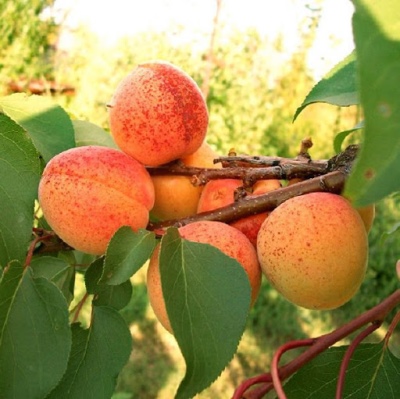
- Authors: A.N. Venyaminov, L.A. Dolmatova
- Tree height, m: 4-6
- Fruit weight, g: 40
- Fruit color: light yellow, with a bright blush
- Pulp color : orange
- Pulp (consistency): dense, juicy, crispy
- Fruit taste: sweet and sour
- Bone size: medium
- Appointment: for fresh consumption, for making compotes
- Ripening terms: average
Apricot variety Kompotny has a universal purpose, its fruits are good both in conservation and fresh. Trees are adapted to growing in a rather harsh climate, they tolerate return frosts well. The variety is well protected from diseases and pests, unpretentious to growing conditions.
Breeding history
The authors of the variety are L. A. Dolmatova and A. N. Venyaminov. Compote obtained from a seedling of the Triumph Severny variety as a result of free pollination. The selection department of the Voronezh Agricultural Academy was engaged in obtaining a hybrid.
Description of the variety
The trees near Kompotnoye are vigorous, 4-6 m high. The crown is compact, but dense. Shoot-forming ability is good, kidney awakening also has high rates. The tree has a well-developed root system, it grows a considerable distance in and around the trunk. The leaf plates on the branches are rigid, oval, dark green, with jagged edges.
Fruit characteristics
The fruits are large enough, with an average weight of 40 g. The skin is light yellow, with a bright dotted blush of a carmine-red tone. The pulp underneath is a rich orange color. The stone is medium, with a bitter core, well detachable.
The shape of the fruit is ovoid, flattened on the sides, pubescent surface. The aroma of the fruit is not pronounced, light. Apricots are well stored due to their dense skins, they do not dents during transportation.
Taste qualities
The sweet and sour taste of the fruit is in good harmony with the crispy, juicy texture of the pulp. Apricots of this variety are not suitable for drying due to the small amount of sugars.
Ripening and fruiting
The first apricots from the tree are harvested 4 years after planting. The variety is of medium ripening, ripe fruits can be obtained in early August.

Yield
On average, 27-34 kg of apricots are harvested from a tree. A ten-year-old tree gives yields in the 45-50 kg range.
Growing regions
Compote is a thermophilic apricot. He feels best of all in the Central Black Earth regions. There is experience in plant cultivation in the Kaliningrad and Leningrad regions.
Self-fertility and the need for pollinators
The variety is self-fertile. He needs pollination with other apricots with the same flowering dates, in late April and early May. For these purposes, the variety Dessertny, Triumph northern, Krasnoschekiy is suitable.
Growing and care
Despite its high drought tolerance, the tree needs frequent watering during the growth period. If you leave the plant without additional moisture during flowering, fruit setting, by mid-July they will begin to crumble. At 1 year after planting, watering is done monthly, combining it with fertilizing with mineral complexes.
The crown of this variety of apricots thickens quickly. She needs more than spring pruning. Summer pinching is carried out, thinning the weakest shoots.



Disease and pest resistance
Comprehensive assessment of tree immunity is good. Compote apricot is almost not affected by moniliosis, dense leaves are not very attractive for leaf-gnawing parasitic insects.

Winter hardiness and the need for shelter
Apricot Kompotny belongs to the winter-hardy varieties. It can withstand frosts down to -30 degrees. Flower buds are not damaged by recurrent spring chills. Trees are also resistant to bark damping.
Location and soil requirements
The soil is preferably dry. The place is selected high, bathed in the sun, not blown by the winds.
Review overview
According to gardeners, the main advantage of Kompotny apricot can be considered its ability to withstand sudden changes in climatic conditions. Even when frozen, the plant quickly regains its crown volume. Mature trees easily cope with droughts, prolonged periods of rains, winter thaws, spring temperature drops. In small areas, summer residents recommend growing this variety on the OP-23-23 rootstock or similar. Then the height of an adult tree will not exceed 2 m.
Other positive aspects of gardeners include resistance to diseases, early onset of fruiting, good suitability of fruits for processing, conservation. The variety is considered commercially promising. But there are also disadvantages. When fresh, the taste of the fruit is far from ideal, it is quite simple, even insipid, in the absence of pollinators, barren flowers form on the tree instead of harvest.































































